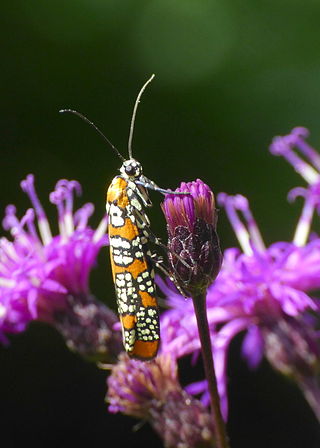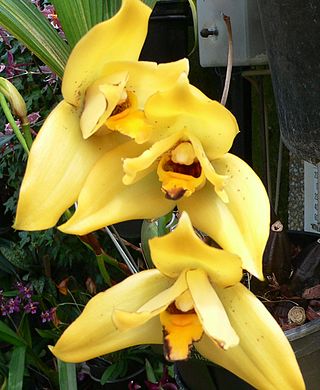
The Domus Aurea was a vast landscaped complex built by the Emperor Nero largely on the Oppian Hill in the heart of ancient Rome after the great fire in 64 AD had destroyed a large part of the city.

Saint Giles, also known as Giles the Hermit, was a hermit or monk active in the lower Rhône most likely in the 7th century. Revered as a saint, his cult became widely diffused but his hagiography is mostly legendary. A town that bears his name grew up around the monastery he purportedly founded, which became a pilgrimage centre and a stop on the Way of Saint James. He is traditionally one of the Fourteen Holy Helpers.

The ailanthus webworm is an ermine moth now found commonly in the United States. It was formerly known under the scientific name Atteva punctella. This small, very colorful moth resembles a true bug or beetle when not in flight, but in flight it resembles a wasp.

The Lei Áurea, officialy Law No. 3,353 of 13 May 1888, is the law that abolished slavery in Brazil. It was signed by Isabel, Princess Imperial of Brazil (1846–1921), an opponent of slavery, who acted as regent to emperor Pedro II, who was in Europe.

Bucks Fizz were an English pop group that achieved success in the 1980s, most notably for winning the 1981 Eurovision Song Contest with the song "Making Your Mind Up". The group was formed in January 1981 specifically for the contest and comprised four vocalists: Bobby G, Cheryl Baker, Mike Nolan and Jay Aston. They received attention for the dance routine which accompanied the song, in which the male members of the group ripped the female members' outer skirts off to reveal much shorter mini-skirts beneath. The group went on to have a successful career around the world, but the UK remained their biggest market, where they had three No.1 singles with "Making Your Mind Up" (1981), "The Land of Make Believe" (1981) and "My Camera Never Lies" (1982) and became one of the top-selling groups of the 1980s. They also had UK Top 10 hits with "Now Those Days Are Gone" (1982), "If You Can't Stand the Heat" (1982), "When We Were Young" (1983) and "New Beginning " (1986). Bucks Fizz have sold over 50 million records worldwide.

The hybrid elm cultivar Ulmus × hollandica 'Wredei', also known as Ulmus × hollandica 'Dampieri Aurea' and sometimes marketed as Golden Elm, originated as a sport of the cultivar 'Dampieri' at the Alt-Geltow Arboretum, near Potsdam, Germany, in 1875.

The Field Elm cultivar Ulmus minor 'Viminalis Aurea', probably a "golden" form of Ulmus minor 'Viminalis', was raised before 1866 by Egide Rosseels of Louvain, who was known to have supplied 'Viminalis'.
The Wych Elm cultivar Ulmus glabra 'Latifolia Aurea' was listed by Schelle in Beissner et al, Handbuch der Laubholz-Benennung (1903), as Ulmus glabraMillerlatifolia aurea, but without description. In the Netherlands in the late 19th and early 20th centuries, however, Ulmus montana latifolia aurea was a synonym of the wych cultivar 'Lutescens', and Green reclassified Schelle's 'Latifolia aurea' as a form of U. glabraHudson.
The hybrid elm cultivar Ulmus × hollandica 'Macrophylla Aurea' was listed by Bean in Kew Hand-List Trees & Shrubs, ed. 3, 273, 1925 as U. montana var. macrophylla aurea, but without description.

Áurea is a municipality in the state of Rio Grande do Sul, Brazil. As of 2020, the estimated population was 3,535.

Ficus aurea, commonly known as the Florida strangler fig, golden fig, or higuerón, is a tree in the family Moraceae that is native to the U.S. state of Florida, the northern and western Caribbean, southern Mexico and Central America south to Panama. The specific epithet aurea was applied by English botanist Thomas Nuttall who described the species in 1846.

The term grex, derived from the Latin noun grex, gregis, meaning 'flock', has been expanded in botanical nomenclature to describe hybrids of orchids, based solely on their parentage. Grex names are one of the three categories of plant names governed by the International Code of Nomenclature for Cultivated Plants; within a grex the cultivar group category can be used to refer to plants by their shared characteristics, and individual orchid plants can be selected and named as cultivars.

Hypnaceae is a large family of moss with broad worldwide occurrence in the class Bryopsida, subclass Bryidae and order Hypnales. Genera include Hypnum, Phyllodon, and Taxiphyllum.
Platygyriella is a genus of moss in the family Hypnaceae. It was described by Jules Cardot in 1854. It occurs mostly in the Americas, parts of Africa, and parts of Asia.
Platygyriella aureoides is a species of moss from the genus Platygyriella. It is found in Africa.
Platygyriella densa is a species of moss from the genus Platygyriella. Platygyriella densa occurs in the Americas and Africa.
Platygyriella frahmii is a species of moss from the genus Platygyriella. It was first described as Pylaisiella frahmii by W.R. Buck in 1993 and transferred to Platygyriella by T. Arikawa in 2004. It is found in Africa at an elevation of 2100 meters.
Platygyriella imbricatifolia is a species of moss belonging to the genus Platygyriella. Before being named Platygyriella imbricatifolia, it was placed in the genus Erythrodontium by R.S. Williams and Jules Cardot. It was then transferred to the genus Platygyriella by Marie Hypolite Irénée Thériot in 1926.
Platygyriella kirtikarii is a species of moss from the genus Platygyriella. It was discovered in Asia and only occurs in Asia. Before the name Platygyriella kirtikarii, it was named Bryosedgwickia kirtikarii by Cardot & Dixon.
Platygyriella jamaicensis is a species of moss belonging to the genus Platygyriella. It was discovered in Jamaica in 1936 by E.B. Bartram It has branches with a size length of about 1–1.5 cm (0.39–0.59 in). It has leaves with the length of about 1.4 mm (0.055 in) with an erect top, straight edges, and curved below. It has perichaetal erect leaves spreading, plant with 4–6 mm (0.16–0.24 in) leaves, which are very smooth and thin with an oblong-cylindrical and can reach up to 1.4 mm (0.055 in). It has a basilar crown with are 15–20 μm and yellow.









